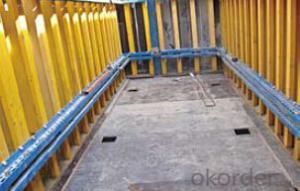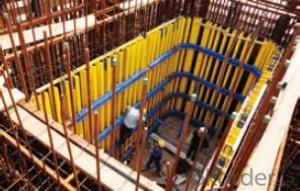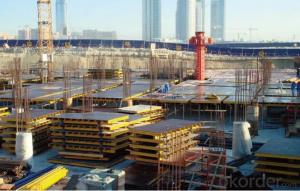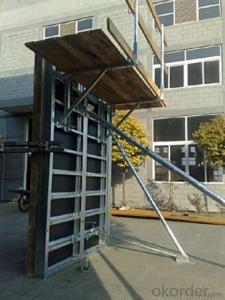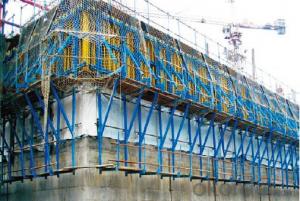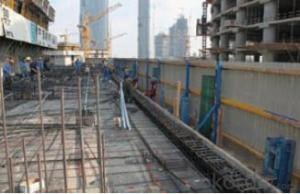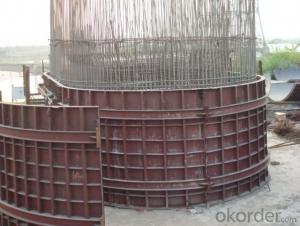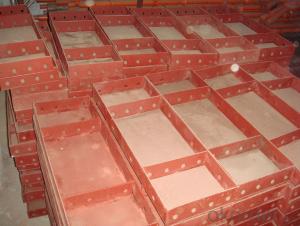Shaft Platform S40 System for Formwork and Scaffolding
- Loading Port:
- Tianjin
- Payment Terms:
- TT OR LC
- Min Order Qty:
- 50 m²
- Supply Capability:
- 1000 m²/month
OKorder Service Pledge
Quality Product, Order Online Tracking, Timely Delivery
OKorder Financial Service
Credit Rating, Credit Services, Credit Purchasing
You Might Also Like
Shaft Platform
As operating platform, the shaft platform is mainly used in the concrete pouring of elevator shaft,
equipment shaft, stair shaft of high-rise building and so on.
Characteristics:
◆ The length of shaft beam is adjustable.
◆ Flexible structure makes lifting easier.
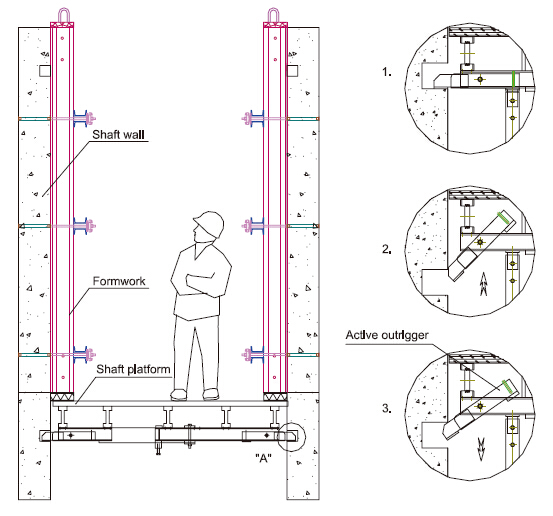
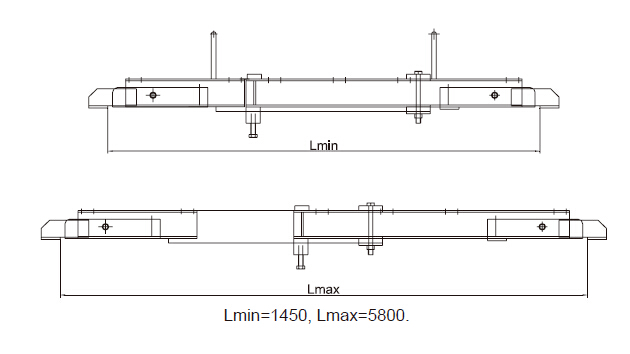
- Q: Can steel formwork be used in underground structures?
- Yes, steel formwork can be used in underground structures. Steel formwork is a versatile and durable construction material that can withstand the challenging conditions of underground structures. It offers excellent strength and stability, making it suitable for constructing walls, columns, and slabs in underground spaces. One of the key advantages of steel formwork is its ability to resist the pressure exerted by the surrounding soil and water. Underground structures often face high hydrostatic pressure, and steel formwork can easily withstand this pressure without deforming or collapsing. This ensures the safety and stability of the structure. Additionally, steel formwork is reusable, which makes it a cost-effective choice for underground construction projects. Its robustness allows it to withstand multiple uses, reducing the need for frequent replacements and lowering overall construction costs. Moreover, steel formwork offers flexibility in design and can be easily customized to meet specific project requirements. It can be fabricated into various shapes and sizes, allowing for the creation of complex geometries in underground structures. However, it is important to note that steel formwork requires proper surface treatment to protect it from corrosion in the underground environment. Special coatings or galvanization can be applied to prevent rusting and prolong the lifespan of the formwork. Overall, steel formwork is a suitable choice for underground structures due to its strength, durability, reusability, and flexibility in design. It can effectively withstand the challenges posed by the underground environment and ensure the long-term stability and safety of the structure.
- Q: Can steel formwork be used for underground parking structures?
- Yes, steel formwork can be used for underground parking structures. Steel formwork provides a strong and durable solution for constructing the walls, columns, and slabs of underground parking structures. It offers several advantages such as high strength, flexibility, and the ability to withstand the pressure exerted by the soil and water in underground conditions. Steel formwork also allows for faster construction compared to traditional formwork systems, as it can be easily assembled and disassembled, and it requires minimal maintenance. Additionally, steel formwork is reusable, making it a cost-effective choice for underground parking structures. Overall, steel formwork is a suitable and efficient option for constructing underground parking structures.
- Q: What are the different types of steel formwork available?
- In the construction industry, there exists a variety of steel formwork options, each possessing its own distinctive characteristics and benefits. Some of the most prevalent variations include: 1. Modular steel formwork: This formwork type comprises pre-made steel panels that can be effortlessly assembled and disassembled. It boasts customization capabilities and can accommodate concrete structures of diverse shapes and sizes. 2. Tunnel formwork: Specifically designed for tunnel and underground structure construction, this formwork variant is forged from steel plates. Its robust construction enables it to withstand high pressure and deliver a polished finish to the concrete. 3. Climbing formwork: Tailored for tall structures such as skyscrapers, climbing formwork is engineered to be lifted and moved vertically as construction progresses. This type of formwork ensures both safety and efficiency during the construction of multi-story buildings. 4. Steel soldier formwork: A versatile and cost-effective option often employed for walls and columns, steel soldier formwork is constructed using steel beams and soldiers. It can be easily adjusted to accommodate different heights and widths. 5. Steel frame formwork: Comprised of steel frames with attached plywood or metal panels, this lightweight formwork type is easy to handle and guarantees a smooth concrete finish. 6. Steel table formwork: Ideal for large horizontal slabs, steel table formwork utilizes steel tables supported by props or scaffolding. Its quick assembly and dismantling make it perfect for projects with tight timelines. These examples represent only a fraction of the available steel formwork options. The selection of formwork depends on project-specific requirements, including the structure type, load-bearing capacity, and desired finish.
- Q: Can steel formwork be used for both residential and commercial projects?
- Yes, steel formwork can be used for both residential and commercial projects. Steel formwork is versatile and can be customized to suit different project requirements, making it suitable for a wide range of construction projects, including both residential and commercial buildings.
- Q: What are the common safety guidelines when working with steel formwork in confined spaces?
- When working with steel formwork in confined spaces, some common safety guidelines include ensuring proper ventilation to prevent the buildup of hazardous gases, regularly monitoring the atmosphere for toxic substances, providing adequate lighting and emergency exit routes, wearing appropriate personal protective equipment such as gloves, safety glasses, and respiratory protection, training workers on the potential hazards and safe work practices, and having a standby person outside the confined space to monitor and assist if needed.
- Q: How does steel formwork affect the overall energy efficiency of the structure?
- The overall energy efficiency of a structure can be significantly influenced by steel formwork. One of the main advantages of utilizing steel formwork is its capacity to deliver a high degree of thermal insulation. Steel possesses a low thermal conductivity, which means it does not easily transfer heat. This characteristic aids in minimizing heat loss or gain through the walls, floors, and ceilings of the structure. The use of steel formwork allows for improved sealing of the building envelope, which reduces air infiltration and enhances the overall airtightness of the structure. This prevents undesired air leakage, which can result in energy loss and decreased energy efficiency. Steel formwork also enables better control of moisture and humidity levels, which is crucial for maintaining a comfortable indoor environment and preventing mold or moisture-related problems. Moreover, steel formwork offers a durable and long-lasting construction solution. It can withstand extreme weather conditions, seismic activities, and other external forces, guaranteeing the structural integrity of the building for many years. This durability reduces the need for frequent repairs or replacements, leading to energy and resource savings in the long run. Additionally, steel formwork is a sustainable choice as it is frequently made from recycled materials and can be recycled at the end of its lifespan. The utilization of recycled steel diminishes the carbon footprint associated with construction and aids in the conservation of natural resources. The recyclability of steel formwork also means that it can be repurposed or reused in future projects, further reducing waste and environmental impact. In conclusion, steel formwork positively impacts the overall energy efficiency of a structure through its excellent thermal insulation, enhanced airtightness, moisture control, durability, and sustainability. By selecting steel formwork, builders can create energy-efficient buildings that are environmentally friendly and cost-effective in the long term.
- Q: How does steel formwork handle different concrete finishing techniques?
- Steel formwork offers a wide range of possibilities for concrete finishing techniques due to its high versatility. It possesses great strength and durability, enabling it to withstand the pressure and forces exerted throughout various finishing procedures. When aiming for a smooth finish, steel formwork provides a solid and stable surface that facilitates easy pouring and leveling of the concrete. Its rigidity guarantees that the concrete remains in position and does not sag or deform during the finishing process. Consequently, the concrete can be smoothly troweled, resulting in a polished and uniform surface. Steel formwork is also suitable for textured finishes. It can be customized with different patterns and textures to create unique and decorative concrete surfaces. By utilizing specially designed steel formwork, such as those with corrugated or embossed patterns, the concrete can be poured to replicate these designs, resulting in visually appealing textured finishes. Furthermore, steel formwork is capable of accommodating exposed aggregate finishes. This technique involves removing the top layer of concrete to reveal the underlying aggregate stones, thus creating a decorative effect. Steel formwork can be designed with removable panels or inserts that allow the concrete to be poured in a way that exposes the desired amount of aggregate. After the concrete has cured, these removable panels can be easily taken off, revealing the desired exposed aggregate finish. Moreover, steel formwork is suitable for stamped concrete finishes. Stamped concrete involves imprinting patterns or textures onto the concrete surface using specialized stamps. Steel formwork provides a solid foundation for these stamps to be pressed onto, ensuring accurate and consistent imprints. The rigidity of steel formwork prevents the concrete from shifting or deforming during the stamping process, resulting in precise and high-quality stamped finishes. Overall, steel formwork is highly compatible with various concrete finishing techniques. Its strength, stability, and versatility make it an ideal choice for handling different finishing processes, allowing for the creation of smooth, textured, exposed aggregate, and stamped concrete finishes with precision and ease.
- Q: How does steel formwork affect the overall speed of construction?
- Steel formwork can greatly increase the overall speed of construction due to its numerous advantages. Firstly, steel formwork is highly durable and can withstand the pressure of concrete pouring without any deformation or damage. This durability enables multiple reuses of the formwork, eliminating the need to constantly replace it with new materials, thus saving time and cost. Moreover, steel formwork provides a smooth and even surface finish, which reduces the time required for further plastering or finishing work. This smooth finish also ensures accurate and precise alignment of structural elements, resulting in faster and more efficient construction. Additionally, steel formwork is easy to assemble and disassemble, allowing for quick installation and removal. This ease of use eliminates the need for extensive labor and minimizes the time required for the formwork setup, ultimately accelerating the construction process. Furthermore, steel formwork is highly adaptable and can be used for various types of building structures. Its flexibility allows for customization and efficient utilization in different construction projects, increasing the overall speed of construction. In conclusion, the use of steel formwork positively impacts the overall speed of construction by providing durability, smooth finish, easy assembly and disassembly, and adaptability. These advantages result in time and cost savings, efficient construction processes, and ultimately faster project completion.
- Q: Can steel formwork be used for both horizontal and vertical structures?
- Yes, steel formwork can be used for both horizontal and vertical structures. Steel formwork is versatile and can be easily adjusted and assembled to meet the requirements of different construction projects, whether they involve horizontal slabs or vertical walls and columns. Its strength and durability make it suitable for a wide range of applications in various types of structures.
- Q: Are there any disadvantages to using steel formwork?
- Yes, there are disadvantages to using steel formwork. One major disadvantage is the high initial cost. Steel formwork is more expensive to purchase or rent compared to other types of formwork, such as wood or plastic. This can be a significant factor for smaller construction projects or for contractors on a tight budget. Another drawback is the weight of steel formwork. Steel is much heavier than other materials, which can make it more difficult to handle and transport. This can increase labor costs and require more manpower to set up and dismantle the formwork. Additionally, steel formwork requires skilled labor to assemble and dismantle properly. It is important to have experienced workers who understand the correct procedures and techniques to ensure the safety and stability of the formwork. This can add to the overall project cost and time. Steel formwork is also prone to corrosion if not properly maintained. Exposure to moisture and chemicals can cause rust and deterioration, which can compromise the integrity of the formwork and pose safety risks. Regular inspections and maintenance are necessary to prevent and address corrosion issues. Lastly, steel formwork is not as flexible or adjustable as other types of formwork. Once it is fabricated, it is difficult to modify or adjust the formwork to accommodate changes in design or dimensions. This lack of flexibility can be a disadvantage in projects where modifications or adjustments are frequently needed. Overall, while steel formwork offers advantages such as durability and reusability, it also has disadvantages that need to be considered when choosing the appropriate formwork for a construction project.
Send your message to us
Shaft Platform S40 System for Formwork and Scaffolding
- Loading Port:
- Tianjin
- Payment Terms:
- TT OR LC
- Min Order Qty:
- 50 m²
- Supply Capability:
- 1000 m²/month
OKorder Service Pledge
Quality Product, Order Online Tracking, Timely Delivery
OKorder Financial Service
Credit Rating, Credit Services, Credit Purchasing
Similar products
Hot products
Hot Searches
Related keywords
